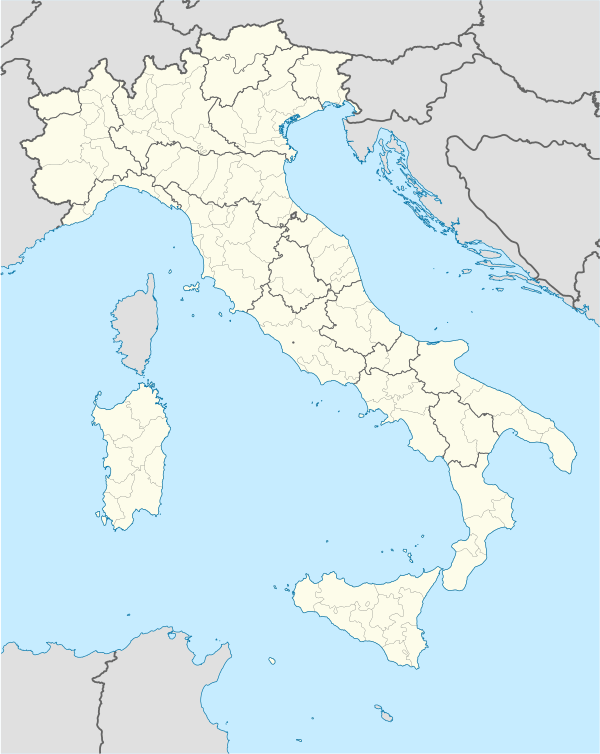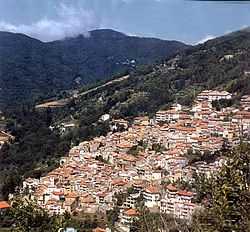San Pietro Apostolo
| San Pietro Apostolo | |
|---|---|
| Comune | |
| Comune di San Pietro Apostolo | |
|
San Pietro Apostolo | |
 San Pietro Apostolo Location of San Pietro Apostolo in Italy | |
| Coordinates: 39°00′15″N 16°28′04″E / 39.00417°N 16.46778°ECoordinates: 39°00′15″N 16°28′04″E / 39.00417°N 16.46778°E | |
| Country | Italy |
| Region | Calabria |
| Province | Catanzaro (CZ) |
| Government | |
| • Mayor | Francesco Fragale |
| Area | |
| • Total | 13 km2 (5 sq mi) |
| Elevation | 500 m (1,600 ft) |
| Population (2001) | |
| • Total | 1,925 |
| • Density | 150/km2 (380/sq mi) |
| Demonym | Petresi |
| Time zone | CET (UTC+1) |
| • Summer (DST) | CEST (UTC+2) |
| Postal code | 88040 |
| Dialing code | 0961 |
| Patron saint | St. Peter |
San Pietro Apostolo is a comune and town in the province of Catanzaro in the Calabria region of Italy. It is about 15.3 kilometres (9.5 mi) miles northwest of Catanzaro, the provincial capital.
Perched on a hillside, it occupies 11.51 square kilometres (4.44 sq mi) and had a population of 1,925 inhabitants in 2001.[1] It is surrounded by the villages of Decollatura, Gimigliano, Miglierina, Serrastretta and Tiriolo. The largest nearby town is Nicastro, which has since become part of the larger comune of Lamezia Terme.
The parish church is that of San Pietro. Other churches in S. Pietro are Madonna di Carmelo and Madonna della Lettera.
Historical notes
The best available knowledge regarding the history of San Pietro Apostolo [2] indicates that it was founded by peasants who fled from Motta Santa Lucia[3] after the earthquake of 1638. Moving to the interior, they asked asylum of Prince Cigala of Tiriolo, who allowed them to settle in the area which is today known as "Colla Pagliara", in exchange for the payment of a modest head tax. They subsequently moved to a lower area which was more sheltered from the wind. It is said that a small statue of the apostle St. Peter was erected in these regions, and that the village was named accordingly. San Pietro Apostolo was administered by its neighbor Tiriolo until the end of the 18th century when it obtained its autonomy under law No. 14 of 19 January 1807. It was elevated to the status of a comune with the name of 'San Pietro a Tiriolo' and placed under the jurisdiction of what was then called Calabria Ulteriore, which consisted of the current provinces of Catanzaro, Crotone, Reggio Calabria and Vibo Valentia. On 4 May 1811 the comune was given the name of San Pietro Apostolo, attesting its separation from Tiriolo which remained, however, the administrative seat. Law No. 360 of 1 May 1816 transferred the village of San Pietro Apostolo with its 1992 inhabitants from the administration of Tiriolo to that of Gimigliano, and from the province of Calabria Ultra to the new province of Calabria Ultra Seconda (Catanzaro).
The most famous episode in the history of San Pietro Apostolo is the stopover of Giuseppe Garibaldi on the night of 28 August 1860. The leader of the Expedition of the Thousand, coming from Maida, was a most welcome guest of the Garibaldi supporter Anselmo Tomaini (already condemned to death by the Bourbons for having been one of the supporters of the movements of Maida and Filadelfia) where, with his closest collaborators, he took note of the situation and planned the forthcoming operations that would have opened the roads to Naples; on the same night Francisco Stocco, with only a few men, induced the surrender of 10,000 men commanded by General Ghio and encamped at Soveria Mannelli, by cleverly having ignited numerous fires placed very visibly on the surrounding heights. Garibaldi's visit is commemorated by two tablets placed on walls of the Tomaini Palace in 1887 and 1961. There are two noble houses in the historical center of San Pietro: the mentioned Tomaini Palace and the Mazza Palace. These were repeatedly targeted by bandits and still preserve their defense systems, among which are two holes through which hot oil was cast out onto attackers who tried to break down the doors.

In the course of the 17th century, an important role was played in the economy of San Pietro by the harvesting and processing of gorse (it. 'ginestra'), a fibrous plant that was softened in the Amato river below the village. This provided a fiber which was used by local spinners for the production of cloth. Silkworm breeding was also very common - the worms were fed on white mulberry leaves which were present in the area. The silk thus produced was almost all locally processed and for the most part marketed in Catanzaro, Nicastro and also in the neighboring town of Serrastretta.
In the early 1920s, the village was divided into several wards: Fundacu (on the national road); Vrugale (from the national road to Calvary Hill; Valla (from Calvary Hill to the school building); Savuci (Independence street); Timpariellu (from the school building to the Mazza butcher shop); Piazzetta (the area around Santino Mazza's store); Cerasiellu (named for a local bend in the road); Magazinu (Marconi Square), Chianu e Mazza (the Mazza palace); Granduani (Venezia street); Un Zeta (the tract from the upper fountain to Piazza Roma); Chiazza (Piazza Roma); and Mulijiti (today's Gramsci Street).
Traditions and folklore

The comune is noted for the celebration of Holy Week. Particularly notable is the traditional "Pigliata" or "Pigghiata", the sacred play representing the passion and death of Jesus Christ, written in prose in 1880 by an anonymous citizen of S. Pietro and produced for the first time on 18 February of the same year. It consists of 5 acts and 52 scenes, lasts about 8 hours and is performed in the small plaza in front of the Church.
The feast of San Pietro is celebrated on 29 June. The feast of Madonna di Carmelo begins on 14 July and lasts for three days, and that of Madonna della Lettera is celebrated on the last Sunday of September, during which the final torch procession has particular significance.
References
- ↑ Comune di San Pietro Apostolo (CZ) - Italia: Informazioni
- ↑ Cenni Storici SAN PIETRO APOSTOLO
- ↑ Motta Santa Lucia - The town of Motta Santa Lucia - Calabria in details
External links
- (Italian)Comuni-Italiani.it - S. Pietro Apostolo
- (Italian)An additional site about S. Pietro
- (Italian)More information about S. Pietro
